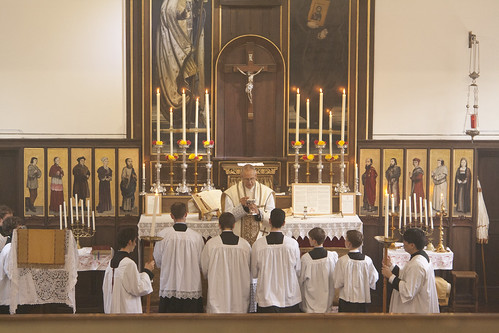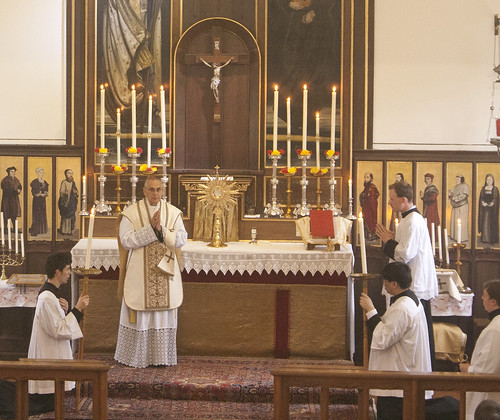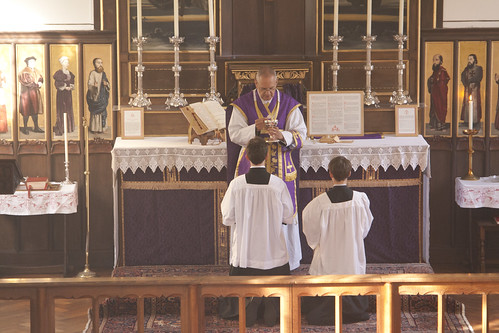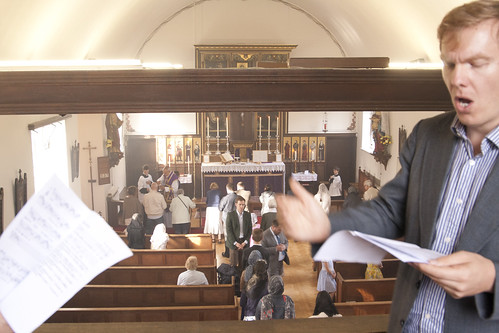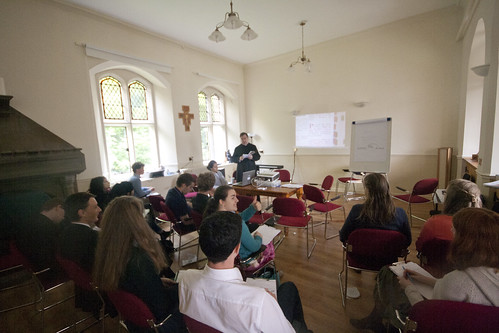Chairman's Blog
Another Pro-Life Mass in Oxford
 Further to my proposal, following the abortion referendum in Ireland, for Masses of Reparation for abortion, we had one such Mass in Oxford recently; another is shortly to take place in London.
Further to my proposal, following the abortion referendum in Ireland, for Masses of Reparation for abortion, we had one such Mass in Oxford recently; another is shortly to take place in London.
Wednesday 4th July, 7:30pm
7pm Wednesday 4th July, Sung Mass.
Our Lady of the Assumption, 10 Warwick Street, London W1B 5LZ
These are both Votive Masses pro remissione peccatorum: for the remission (forgiveness) of sin.
I had proposed the celebration not only that Votive Mass but also of Masses in honour of Our Lady of Guadalupe. This title of the Blessed Virgin Mary refers to her appearance in 1531 in New Spain (now Mexico). Among other things she arranged a miraculous image of herself to be indelibly imprinted on the cactus-fibre cloak of the seer, a humble peasant; this image can still be seen. Its survival for nearly 500 years itself defies natural explanation; so does the means used to create the image. Our Lady of Guadalupe was declared Patroness of the Americas by Pope Pius XII in 1946. She has been adopted as a patron of the Pro-Life movement because the image represents her during pregnancy: a state indicated (in accordance with the conventions of the time) by her black girdle.
Her feast-day, where it is celebrated, is on 12th December (the date in 1531 when the miraculous image was created). My intention is that we have a Votive Mass of Our Lady of Guadalupe as close as possible to this date, and if possible before the end of the University term.
I can now announce that a Sung Votive Mass of Our Lady of Guadalupe will be celebrated in Oxford for the intentions of the Pro-Life movement:
6pm Wednesday 28th November
SS Gregory and Augustine, 322 Woodstock Road, OX2 7NS
Support the work of the LMS by becoming an 'Anniversary Supporter'.
Cardinal Müller on the liberal agenda
These astonishing but perceptive words of Gerhard, Cardinal Müller, former Prefect of the Congregation for the Doctrine of the Faith, from an interview with Catholic World Report, deserve as wide an audience as possible.
They consider the secularization and de-Christianization of Europe as an irreversible development. For this reason the New Evangelization—the program of John Paul II and Benedict XVI—is in their view a battle against the objective course of history, resembling Don Quixote’s battle against the windmills. They are seeking for the Church a niche where it can survive in peace. Therefore all the doctrines of the faith that are opposed to the “mainstream,” the societal consensus, must be reformed.
One consequence of this is the demand for Holy Communion even for people without the Catholic faith and also for those Catholics who are not in a state of sanctifying grace. Also on the agenda are: a blessing for homosexual couples, intercommunion with Protestants, relativizing the indissolubility of sacramental marriage, the introduction of viri probati and with it the abolition of priestly celibacy, approval for sexual relations before and outside of marriage. These are their goals, and to reach them they are willing to accept even the division of the bishops’ conference.
The faithful who take Catholic doctrine seriously are branded as conservative and pushed out of the Church, and exposed to the defamation campaign of the liberal and anti-Catholic media.
It is important to recognise the shape of the liberal project.
1. It is not motivated in the first place by a rejection of the Faith. It is motivated by a reading of history which concludes that a restoration of Catholic culture is impossible, and that in order to survive the Church must find ways to accommodate herself to the hostile secular culture.
2. This process of adaptation, however, leads to a rejection of the Faith. Once the Real Presence, the historic understanding of sin and the priesthood, and the Indissolubility of Marriage have gone, it's not Catholicism any more. This is not consciously accepted by the liberal, however, who thinks he's rejected the chaff and kept the wheat.
3. Implementing the liberal strategy means dialling back any attempts at evangelisation which look as though they are in danger of being successful. It is not the tone or the liturgical preferences or the bad manners of the leaders or followers of this or that apostolate which is the problem. The problem is anything which draws attention to and makes attractive those aspect of the Faith which the liberal thinks should be jettisoned for the good of the Church.
This is a difficult point to grasp but it is important. The answer to the question 'is liberal Catholicism a diabolical conspiracy to destroy the Church?' is 'No': liberal Catholics are almost always sincere, often pious, frequently hard-working, with a serious analysis of the situation of the Church and the World which focuses on genuine, difficult realities about the current state of things.
The problem is that they strategy they have adopted, unlike traditional apostolic work, requires not just that they do things; it requires other people to stop doing things. This pushes them into a position in which they end up doing their utmost to shut down entirely orthodox and pastorally effective initiatives. Indeed, the more orthodox and the more effective, the more they must be shut down. And this looks quite remarkably like a diabolical conspiracy to destroy the Church.
Photos from Corpus Christi at SS Gregory & Augustine's, Oxford.
Support the work of the LMS by becoming an 'Anniversary Supporter'.
My presentation to the Rome Study Day
I gave the short opening address at the Study Day on Modernism in Rome, organised by the Lepanto Foundation, which took place on Saturday. Here it is.
--------------------
[1]
[2]
To the extent that Buttiglione engages in a serious way with the arguments his contribution is to be welcomed, as part of a theological discussion which many of Pope Francis’ self-appointed partisans would prefer not to have. His position makes clear the disadvantages, for them, of this approach, however, since his conclusions do not permit the concrete pastoral proposals which are put forward under the cover of Amoris: notably, he wrote that sinners should receive sacramental Absolution before receiving Holy Communion.What will the Catholic Christian do, if a small part of the Church has cut itself off from the communion of the universal Faith? ... He will prefer the healthiness of the whole body to the morbid and corrupt limb. But what if some novel contagion try to infect the whole Church, and not merely a portion of it? Then, he will take care to cleave to antiquity which cannot now be led astray by any deceit of novelty. But what if in antiquity itself two or three men, or it may be a city, or even a whole province be detected in error? Then he will take the greatest care to prefer the decrees of the ancient General Councils... . But what if some error arises regarding which nothing of this sort can be found? Then he must do his best to compare the opinions of the Fathers... . And whatever he shall find to have been held, approved and taught, not by one or two only, but by all equally and with one consent, openly, frequently, and persistently, let him take this to be held by him without the slightest hesitation.
[3]
[1]
Tweet dated 2nd October 2017[2]
July 19th2016[3]
Commonitorium, II: 3 - III: 4Support the work of the LMS by becoming an 'Anniversary Supporter'.
Blog post reproduced on Conservative Woman
A post from this blog about Feminism, weeds and jerks has been re-published on Conservative Woman: go over there to read it.
Support the work of the LMS by becoming an 'Anniversary Supporter'.
Masses of Reparation
I've been getting behind with my photos, but I want to remind readers not only that the Mass of Reparation for the Abortion Referendum in Ireland took place in Oxford as planned, on Friday 15th, but that another will take place in London:
Wednesday 4th July, 7:30pm
7pm Wednesday 4th July, Sung Mass.
Our Lady of the Assumption, 10 Warwick Street, London W1B 5LZ
The Mass in Oxford was well-attended. It was low-key but beautiful. It is important to understand how the ancient liturgy, and in general authentic Catholic culture, calls on us to embrace a mortified life, a life of penance, but that this does not mean ugliness. Sorrow does not exclude joy; repentance implies hope. The Votive Mass pro remissione peccatorum is about sin, yes, but about God's willingness to enable us to overcome it. The gospel gives us the saying of Our Lord, 'Ask and you shall receive'. If we ask for the grace of repentance, we will receive it. If we ask for forgiveness, God will take us back into his love and friendship. If we ask him to help us restore the evils done by ourselves and by others, he will listen to that also.
Liberal theology is the theology of despair. It says that repentance is impossible for us, a life of grace in the future is impossible for us, a restoration of justice and beauty and innocence is impossible: it tells us to accept the ugliness and depravity and make the most of it. This is absurd: evil, even. At every moment in her history the Church has been making reparation, has been restoring, rebuilding, and purifying: a work of joy which overcomes sorrow. We have restored the fabric of our churches, we have restored the fabric of our societies, and above all, and most lastingly, we have restored the tattered fabric of the human spirit.
These things are only possible with God's help: contrary to the liberal, that is not a euphemism for 'impossible'; it draws our attention, rather, to the need for prayer, and collective, liturgical, prayer, as the centre of our endeavour.
It is not too late to make a start: and not too early, either.
Support the work of the LMS by becoming an 'Anniversary Supporter'.
Conference on Modernism, Rome, Saturday: follow online, live

You can't be in Rome on June 23rd?
Subscribe for € 10 and follow the live streaming of the study day on the theme:
Old and new modernism. The roots of the Church's crisis.
The conference will be broadcast on the YouTube channel of the Italian press agency Corrispondenza romana. The speeches will be in the original language.
All subscribers will receive a private link that will be active from 9am on June 23rd. To register for the live conference click here.
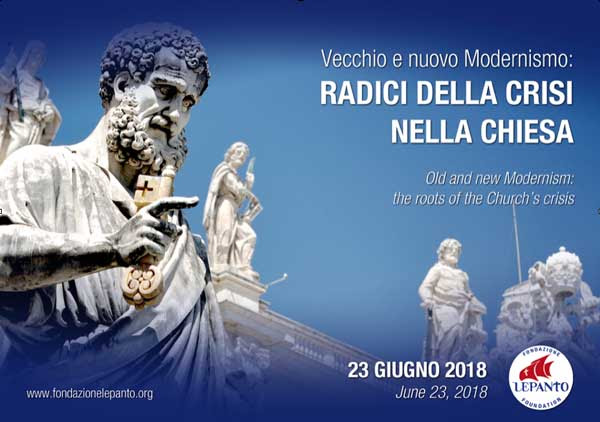
Website: www.fondazionelepanto.org - E-mail: info@fondazionelepanto.org
Corrupt bishops: why it is a problem: Part 1
The shocking news about Cardinal McCarrick prompts me to repost this, from September 2014. The subsequent posts on the series can be seen here and here.
------------------------------
It is hard to think of a precedent in England and Wales for what has happened to Bishop Kieran Conry, though there are plenty from other countries. The downfall of Cardinal O'Brien over the border in Scotland is an obvious one, a closer parallel, however, is afforded by the career of late Bishop of Argyll and the Isles (in north west Scotland), 'Roddy' Wright. I discussed this on this blog because Mgr Basil Loftus had declared that Bishop Wright had merely wanted to get married to the woman he loved. How sweet. Loftus neglected to mention that the wretched Wright had been having affairs with two women, one of them married, simultaneously, and eloped (this was back in 1996) with the one by whom he had not had a child; other affairs had apparently preceded this.
I have no wish to engage in prurient judgmentalism about Bishop Conry, but precisely because this is a new thing for us in England and Wales it is important to consider what we should learn from it.
What Basil Loftus would like us to conclude - and Catherine Pepinster, editor of the Tablet, was quick to make this point on Twitter - is that it is further evidence that mandatory clerical celibacy should be ended. This reaction has become such an ingrained reflex among liberals that they haven't stopped to think about the circumstances of this case. What sort of 'marriage' would have suited Bishop Conry or Bishop Wright? Some sort of free-wheeling polyamorous ménage, one assumes, open to women who are inconveniently married to other men, men who aren't necessarily very happy about sharing the marital bed with their bishop.
No, one must recognise this for what it is. Liberals can talk chirpily about priests merely 'falling in love', and how the problem could be solved by letting them marry, but there is a huge problem here of the priest's spiritual authority, a problem exacerbated when the cleric is a bishop. I've no idea what happened with Bishop Conry, but the stereotyped story, which has happened often enough, is of a woman who comes to a priest with a problem about her marriage, and if the priest is 'down with the kids' and lacks the formality and boundaries vital for the job, they end up in bed together. The priest may be a calculating serial adulterer or he may be naive, but this isn't a normal relationship of equals, or even a 'normal' adulterous affair, because the priest's spiritual authority has the effect of making the women think that, at least in its opening stages, what is happening must be ok, and anyway she is both in awe of him, and aware that he can make things difficult for her if resists. The priest's prestige and authority makes the situation intrinsically problematic, even abusive.
In the recent past, when sanity had not yet departed the education system in despair, it was thought a matter of serious professional misconduct for a teacher or even university tutor to have an affair with a pupil or student, because the teacher's prestige, in the student's eyes, and power over the student, makes the whole thing unfair. This is true to a far greater extent with priests, and even more so with bishops.
Does this mean that it would be hugely problematic simply to end 'clerical celibacy'? Yes it does. How do the Orthodox deal with the problem? They don't: their priests and bishops are not allowed to marry. How can this reality be conveyed through the liberals' thick skulls? Let me say it again: the Orthodox churches do not permit priests and bishops to marry. On the eve of their diaconate seminarians conventionally find a wife, before ordination; if she dies, they may not remarry. Only celibates - generally speaking that means monks - are consecrated bishops. Priests flirting and courting and getting married among the Orthodox? No, no, no.
Please note that when serious people talk about changing the discipline of celibacy in the Latin Church, they are talking about the possibility of adopting the Orthodox approach, and that is what the concessions to convert Anglican clerics amounts to. No serious person imagines that the Church could just allow priests to marry. And married bishops? Forget it. And will priests be allowed to have a series of adulterous affairs one day? Er...
How do the Anglicans manage it? As best they can. One can at least observe that their theology of the ordained ministry does not place create quite such a disproportion of power in the cleric vis-a-vis the object of his, or her, attentions; that courtship and marriage during training or very early in a clerical career is somewhat less problematic, than later; and that clerical courtships have always provided our separated brethren with a rich vein of humour. Who can forget Trollope's superb fictional widow Mrs Bold boxing the ear of the insufferable bishop's chaplain, Mr Slope, in response to his proposal of marriage? The tremulous advances of Dr. Chasuble towards Miss Prism in Oscar Wilde's The Importance of Being Earnest? Or Sydney Smith's observation:
How can a bishop marry? How can he flirt? The most he can say is, 'I will see you in the vestry after service.'
When it comes to priests bound by a vow of celibacy, dealing with (often married) women in a very vulnerable emotional state, seduction, however, is no laughing matter. It is not a peccadillo we should shrug off indulgently. It is a very serious moral evil, with an ever-widening circle of victims. By all means let us pray for Bishop Conry. The revelation of his crimes should make us more vigilant, not less, about the way priests behave.
It is time we put the boot on the other foot. When this kind of thing happens, we must learn to say, not that the rules should be relaxed somehow, but that the touchy-feely, hugging-and-kissing, face-to-face confession, open-necked shirt approach to the priesthood is collapsing under its own contradictions. A more traditional conception of the priesthood is actually the only one which is going to stop behaviour in which women are hurt, children are hurt, husbands are hurt, parishes are hurt, and priests are ultimately destroyed.
 |
| Ordinations in the Traditional rite for the FSSP in Denton, Nabraska, USA |
Support the work of the LMS by becoming an 'Anniversary Supporter'.
Michael Davis attacks home-schoolers
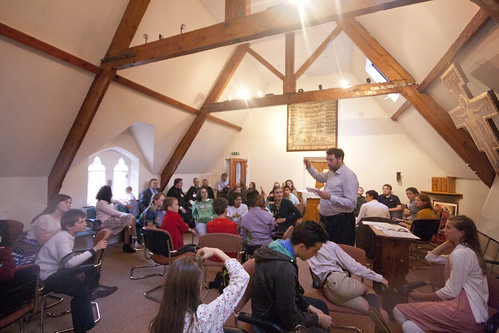 |
| The quiz at the end of the St Catherine's Trust annual Summer School, attended by about 50-50 home-educated and school-educated children. Details of this year's here. |
Cross-posted from Rorate Caeli.
A while ago the Catholic Herald journalist Michael Davis thought he'd do a good turn to the Traditional Catholic movement (with which he apparently identifies) by describing us as hateful bigots and antisemites. Now he's decided to do a similar favour to homeschoolers.
It works like this. First, Davis starts the article with a reference to the staggering success of homeschoolers: it seems that they are providing 10% of vocations to the priesthood in the USA, a proportion vastly in excess of their numbers.
Second, Davis lists all the tired old criticisms of homseschooling. Homeschooling is against the teaching of the Church; the children aren't 'socialised'; the parents are 'helicopter parents' who 'seal off their children in a bubble'; even the apparent good of the vocations is undermined by the snarky suggestion that the vocations aren't genuine and the priests won't be good pastors.
Step three is to hold up his hands and say: Oh well, maybe these problems can be avoided by some homseschoolers. Citing one particular group, he says vocations coming from it 'won’t be stereotypically paranoid, socially awkward homeschooled kids': unlike all the other homeschooled children, right?
No doubt he expects us all to congratulate him on what a balanced article he has produced.
The problem is that, just as in the 'oh perhaps not all traditional Catholics are hateful bigots' article, he has reiterated and reinforced an extremely damaging negative stereotype which needs confronting and assessing. Is it true? Because obviously, if the stereotype isn't true, then a balanced assessment would use it even as one side of the see-saw.
The claim that home education is against the teaching of the Church, perhaps with an exception for 'crisis' circumstances, is obviously insane, since, first, the Church has always taught that parents are the 'primary and principal educators' ('primi et praecipui ...educatores': Gravissimum educationis 3, Vatican II) of their children; and, second, the existence of schools available even to the majority of the population, let alone all of it, is not only historically contingent but historically rare. It is rather more reasonable to say that good Catholic schools, where they exist, can offer educational, social and cultural opportunities homeschoolers will generally find difficult to arrange, and that parents' choice of educational options will take this into account. But that doesn't have quite the same ring to it, does it?
Are children not as well 'socialised' with home education than in standard schools? Is there any actual, you know, evidence out there? Well, here's an article in The Economist, hardly a hippy or traddy publication, which notes:
Nor, on the evidence of Mr Murphy’s book, are they socially backward: most seem confident, assured and well-adjusted. They also have fewer behavioural problems. But one study did find higher attrition rates when they enter the armed forces.
If Davis prefers to keep things at the level of anecdote, I would suggest he spends some time with children from ordinary schools and home-schooled children of equivalent ages. If he has remotely representative children to talk to, he will discover for himself the often-repeated truth that the latter exhibit greater social skills, self-confidence, and intellectual curiosity. In a good many cases, in fact, children are taken out of school and put into a homeschooling routine because the vaunted 'socialisation' of ordinary schools is threatening to do them permanent psychological damage. If Davis has not, in fact, met people who have been badly harmed by the 'socialisation' of standard schools, he needs to get out more.
So, is homeschooling 'the ultimate form of helicopter parenting'? At this point I feel like banging my head on the table. Has he actually talked to any? Home educators don't all have the same educational philosophy, any more than schools do, but it is the nature of homeschooling that teachers can't arrange 24-hr contact time, because the teachers - mostly parents - have other things to do, including other children to teach. This means that children are challenged to work on their own from an early age, and are freer pursue their own interests. Furthermore (and here's a point connected with the question of socialisation), homsechooled children will spend more time in different groups doing things like sports: unlike a parochial school, it won't be the same 30 class-mates in the playground, on the hockey field, and in the chemistry lab. What parents can do, of course, is to establish to their satisfaction that the things their children are doing, and the people they are doing them with, are ok, and intervene if they are not.
Helicopter parenting, if the phrase means anything, is a reaction to the problems of children swapping internet porn, bullying, and inadequate classroom teaching, and it is a reaction which does not work. No amount of ringing up the headmaster and attending parents' meetings can effectively deal with those issues, as we have all heard (those of us who haven't stuck our fingers in our ears) from countless despairing parents. Homeschoolers don't need to 'helicopter' their children because they can ensure that they are safe and are being educated.
Finally, do homeschoolers 'seal their children off' in a 'bubble'? Here's a funny thing. That is what schools are supposed to do. When you send your children off to school, the idea - if there is any idea at all - is that this completely artificial, enormously complicated, and hideously expensive institution constitutes a special environment, contrived after deep thought and long experience, to be uniquely conducive to education and socialisation.
As a matter of fact I don't think schools have ever been very good at socialisation: just read a few school reminiscences, such as the relevant passages of Betchman's Summoned by Bells or Lewis' Surprised by Joy, and the glory days of the English Public School quickly lose their charm. Today, with social-media bullying and the normalisation of playground rape, together with the almost total collapse of educational standards, the majority of schools in the developed world are a uniquely poor environment for both purposes. Like Anthony Esolen, I really wonder if children would be better off running around in the woods on their own. However, that's not the only alternative. Home educating parents set to work to create some kind of educational and socialising environment, and the results show that they they do so with a degree of success, even while leaving their children a lot more time to run around in the woods than children in schools have.
The claim that home educated children who discern vocations make bad priests is, I think, not worthy of a response. It is a disgusting, though apparently thoughtless, slur on hundreds of priests Davis has not met, and to those with the responsibility for forming them. Davis owes them an apology.
Davis does not appear to be interested in thinking seriously about the merits of home education. Perhaps that would be too much effort. Instead he just recycles negative prejudices on the subject while simultaneously admitting that the results don't seem too bad.
If this is what the Catholic press is about today, then it is about as much use as the Catholic educational system.
Support the work of the LMS by becoming an 'Anniversary Supporter'.
Counting our blessings: 10 years of Summorum Pontificum in England and Wales
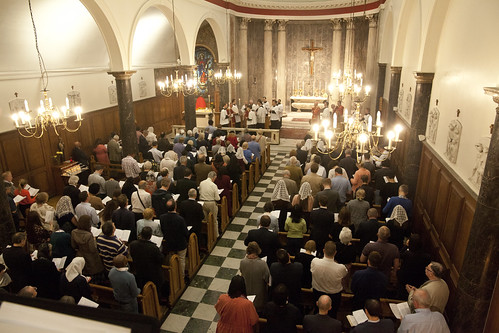 |
| Bishop Schneider in London |
Last summer, on the occasion of the 10th anniversary of Summorum Pontificum, I was asked for illustratative statistics by Paix Liturgique. This is what I came up with, from the Latin Mass Society's records:
Locations with 'every Sunday' Masses (excluding Saturday evening Masses)
2007: 20
2012: 34
2017: 40
Christmas Masses (including Midnight, Dawn, and Day Masses)
2006: 10
2012: 44
2016: 71
I thought of these numbers when my attention was drawn to a post on a somewhat obscure blog which claims, without giving a great deal of even anecdotal evidence, that the Traditional Mass is 'stagnating' in England and Wales.
Another truth about England and Wales is that it is not Singapore: we don't all live in one high-density city. The spread of the Traditional Mass in England and Wales is a matter of getting it onto the parish schedules of more and more churches around the country, so that people can actually get to it. At this point people usually tell me that the Real Trads in the USA think nothing of 4-hour round trips to get to the EF on a Sunday, unlike the feeble people we call Trads here, but I would make two observations. The first is the cost of motor-fuel relative to average incomes in the two places. The second is that as a matter of fact there are a good number of Traditional Catholics who do go to extraordinary lengths to attend the EF, but that is about holding on to what you already know, not trying out something new which you might not like.
Getting the Traditional Mass into a new church, as a regular Sunday fixture, is an extraordinarily difficult thing to do in England and Wales. Our churches are heavily used and our priests are fully committed. Only in quite unusual situations can a time-slot and a priest both be made available. And so, yes, in the five years from 2012 to 2017, progress on this measure was of only 6 churches. Not much more than one a year.
As the squeeze on the number of clergy serving our churches tightens, the attempt to keep up all the existing Masses has made more and more demands on priests' time. One reaction by the bishops has been to try to protect their priests from impossible demands by stopping them creating new Masses, and trying to reduce the numbers of Masses in parishes - it's not as if they are all full - as well as by closing parishes. Drastic changes occasioned by parish mergers can occasionally make new EF Mass times possible, but naturally that is a very slow business.
However, we are winning at a more fundamental level, and this fundamental victory will in time be reflected in the number of Masses. What I mean is in the attitude of bishops and priests, particularly the influential senior clergy, to the Traditional Mass. Ten years ago, and before that, there was a great deal of hostility. While some still cling to that, for the most part this has melted away. It has done so partly as a result of generational change, but also because as the EF has become more widespread and normalised, everyone has been able to see that it, and the priests who say it and the people who attend it, are not freaks or monsters, but faithful Catholics.
Not only is the hostility disappearing, but the number of priests able and wanting to celebrate the Traditional Mass grows with every year that passes. The younger seminarians are not all keen on it, but if 50% of the brighter ones are, things are going to look very different in 20 years' time. And then there is the extraordinary number of vocations to the Traditional Institutes, notably to the Fraternity of St Peter, which have come from England and Wales.
Another issue to bear in mind is that, from the point of view of liturgical renewal, the Traditional Latin Mass has become, for practical purposes, the only show in town. The theoretical and practical impetus for 'Latin Novus Ordo' and varieties of 'Reform of the Reform', which have never spread beyond a tiny number of churches in this country, is played out. True, lots of people still go to the Latin NO in the Oxford and London Oratories, but no one is going to create new ones in new churches. It is a complete liturgical dead-end.
And here is something else. The experience of the last ten years has taught us that when the Traditional Mass is established in a new location, where there is little if any proven demand, it attracts a congregation. With the Traditional Institutes' new churches, this can be a congregation comparable or bigger than the typical prime-time congregation of nearby parish churches. Where we are talking about a church offereing both Forms, and if the Mass times provide a reasonably level playing-field, it can become the most popular Mass of the day. This has happened again and again, and reinforces my point that to spread the Traditional Mass what is needed, in the end, is for it to get into more churches.
It is frustrating to see so many priests who'd like to celebrate the EF on a Sunday in their churches not able to do so. But this pent-up supply is not going away: it is increasing. And when it is able to manifest itself in a new local Mass, it creates its own demand.
I'm optimistic about the future of the Traditional Mass in England and Wales, because of these longer-term trends. I have seen the transition from a generation of openly hostile senior priests and bishops to open-minded ones with other, urgent, issues uppermost in their minds. Knowing what the younger clergy are like, I forsee another transition among senior priests and bishops: from seeing the Traditional Mass as an eccentricity to be tolerated, or an opportunity for the off-loading of a crumbling historic church, to seeing it as a evangelical weapon to be deployed.
When that day comes, will we be ready?
Support the work of the LMS by becoming an 'Anniversary Supporter'.
Young Catholic Adults: Douai Retreat 7-9th Sept
As always I'm delighted to advertise this long-running annual event.
--------------------------------
During the weekend of the 7-9 September 2018, Young Catholic Adults will be running a retreat at Douai Abbey, it will feature Fr. Lawrence Lew O.P., and Canon Poucin - the age range is 18-40.
The weekend will be full-board. YCA will be running the weekend with the Schola Gregoriana of Cambridge who will be holding Gregorian Chant workshops.
There will also be a Marian Procession, Rosaries, Sung Masses, Confession and socials. All Masses will be celebrated in the Extraordinary form.
Please note to guarantee your place this year Douai Abbey have requested that everyone books in 3 weeks before the start of the weekend i.e.17th Aug 2018.
More information: http://youngcatholicadults-latestnews.blogspot.co.uk/
To book:-https://bookwhen.com/youngcatholicadults-douai2018
To donate towards the costs of running the weekend please click here.
Support the work of the LMS by becoming an 'Anniversary Supporter'.

